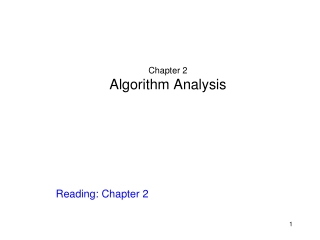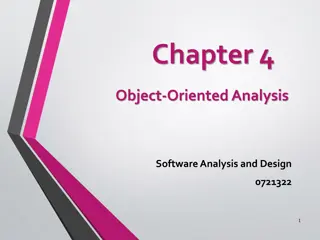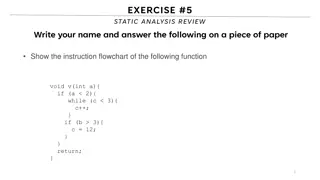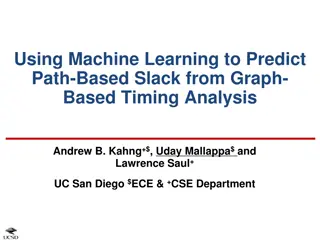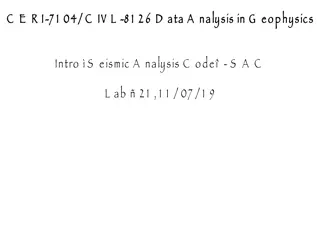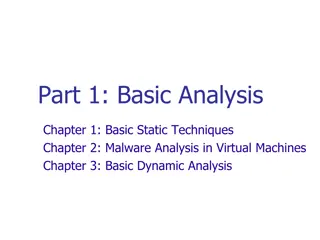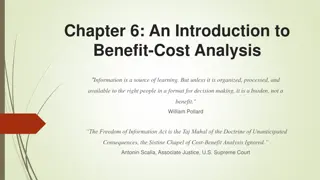
Analysis Methods and Efficiency in Parallel Algorithmic Work
Learn about techniques for analyzing algorithms in parallel computing environments, including mapping true elements, calculating prefix sums, and optimizing work and span. Understand the importance of parallel algorithm efficiency in terms of work and span, as well as the significance of Directed Acyclic Graphs (DAGs) and Fork-Join models in optimizing parallel processes.
Download Presentation

Please find below an Image/Link to download the presentation.
The content on the website is provided AS IS for your information and personal use only. It may not be sold, licensed, or shared on other websites without obtaining consent from the author. If you encounter any issues during the download, it is possible that the publisher has removed the file from their server.
You are allowed to download the files provided on this website for personal or commercial use, subject to the condition that they are used lawfully. All files are the property of their respective owners.
The content on the website is provided AS IS for your information and personal use only. It may not be sold, licensed, or shared on other websites without obtaining consent from the author.
E N D
Presentation Transcript
CSE 332 Winter 2024 Lecture 21: Analysis Nathan Brunelle http://www.cs.uw.edu/332
2 14 9 10 16 4 18 8 , ? ? = ? > 9 Input: Parallel Pack 10 16 18 14 0 1 Output: 6 7 2 3 4 5 1. Do a map to identify the true elements 1 0 1 1 0 1 0 0 2. Do prefix sum on the result of the map to identify the count of true elements seen to the left of each position 4 4 1 2 2 3 3 3 3. Do a map using the previous results fill in the output 10 16 18 14
3. Do a map using the result of the prefix sum to fill in the output 2 14 9 10 16 4 18 8 Input: 1 0 1 1 0 1 0 0 Map Result: 4 4 1 2 2 3 3 3 Prefix Result: Because the last value in the prefix result is 4, the length of the output is 4 Each time there is a 1 in the map result, we want to include that element in the output If element ? should be included, its position matches prefixResult[?]-1 Int[] output = new int[prefixResult[input.length-1]]; FORALL(int i = 0; i < input.length; i++){ if (mapResult[i] == 1) output[prefixResult[i]-1] = input[i]; }
Parallel Algorithm Analysis How to define efficiency Want asymptotic bounds Want to analyze the algorithm without regard to a specific number of processors
Work and Span Let ??? be the running time if there are ? processors available Two key measures of run time: Work: How long it would take 1 processor, so ?1? Just suppose all forks are done sequentially Cumulative work all processors must complete For array sum: (?) Span: How long it would take an infinite number of processors, so ? ? Theoretical ideal for parallelization Longest dependence chain in the algorithm Also called critical path length or computation depth For array sum: (log?)
Directed Acyclic Graph (DAG) A directed graph that has no cycles Often used to depict dependencies E.g. software dependencies, Java inheritance, dependencies among threads! 1 3 2
ForkJoin DAG Fork and Join each create a new node Fork branches into two threads Those two threads depended on their source thread to be created Join combines to threads The thread doing the combining depends on the other threads to finish Divide Base Cases Combine
More Vocab Speed Up: How much faster (than one processor) do we get for more processors ?1? /??? Perfect linear Speedup ??= ? Hard to get in practice Holy Grail or parallelizing Parallelism Maximum possible speedup ?1/? At some point more processors won t be more helpful, when that point is depends on the span Writing parallel algorithms is about increasing span without substantially increasing work ?1
Asymptotically Optimal ?? We know how to compute ?1 and ? , but what about ??? ?? cannot be better than ?1 ? ??cannot be better than ? An asymptotically optimal execution would be ?1? ? + ? ? ?1(?)/? dominates for small ?, ? ? dominates for large ? ForkJoin Framework gives an expected time guarantee of asymptotically optimal! ??? ?
Division of Responsibility Our job as ForkJoin Users: Pick a good algorithm, write a program When run, program creates a DAG of things to do Make all the nodes a small-ish and approximately equal amount of work ForkJoin Framework Developer s job: Assign work to available processors to avoid idling Abstract away scheduling issues for the user Keep constant factors low Give the expected-time optimal guarantee
And now for some bad news In practice it s common for your program to have: Parts that parallelize well Maps/reduces over arrays and other data structures And parts that don t parallelize at all Reading a linked list, getting input, or computations where each step needs the results of previous step These unparallelized parts can turn out to be a big bottleneck
Amdahls Law (mostly bad news) Suppose ?1= 1 Work for the entire program is 1 Let ? be the proportion of the program that cannot be parallelized ?1= ? + 1 ? = 1 Suppose we get perfect linear speedup on the parallel portion ??= ? +1 ? ? For the entire program, the speed is: ??= ?+1 ? ? And so the parallelism (infinite processors) is: ? ?1 1 ?1 ?_ =1
Ahmdals Law Example Suppose 2/3 of your program is parallelizable, but 1/3 is not. ? =2 3 ?1=2 ??= ? +1 ? ? So if ?1 is 100 seconds: ??= 33 +67 ? ?3= 33 +67 3+1 3= 1 3= 33 + 22 = 55
Conclusion Even with many many processors the sequential part of your program becomes a bottleneck Parallelizable code requires skill and insight from the developer to recognize where parallelism is possible, and how to do it well.
Reasons to use threads (beyond algorithms) Code Responsiveness: While doing an expensive computation, you don t what your interface to freeze Processor Utilization: If one thread is waiting on a deep-hierarchy memory access you can still use that processor time Failure Isolation: If one portion of your code fails, it will only crash that one portion.
Memory Sharing With ForkJoin Idea of ForkJoin: Reduce span by having many parallel tasks Each task is responsible for its own portion of the input/output If one task needs another s result, use join() to ensure it uses the final answer This does not help when: Memory accessed by threads is overlapping or unpredictable Threads are doing independent tasks using same resources (rather than implementing the same algorithm)
Example: Shared Queue Imagine two threads are both using the same linked list based queue. enqueue(x){ } if ( back == null ){ back = new Node(x); front = back; } else { back.next = new Node(x); back = back.next; } What could go wrong?
Concurrent Programming Concurrency: Correctly and efficiently managing access to shared resources across multiple possibly-simultaneous tasks Requires synchronization to avoid incorrect simultaneous access Use some way of blocking other tasks from using a resource when another modifies it or makes decisions based on its state That blocking task will free up the resource when it s done Warning: Because we have no control over when threads are scheduled by the OS, even correct implementations are highly non-deterministic Errors are hard to reproduce, which complicates debugging
Bank Account Example The following code implements a bank account object correctly for a synchronized situation Assume the initial balance is 150 What Happens here? class BankAccount { private int balance = 0; int getBalance() { return balance; } void setBalance(int x) { balance = x; } void withdraw(int amount) { int b = getBalance(); if (amount > b) throw new WithdrawTooLargeException(); setBalance(b amount); } // other operations like deposit, etc. } withdraw(100); withdraw(75)
Bank Account Example - Parallel Assume the initial balance is 150 class BankAccount { private int balance = 0; int getBalance() { return balance; } void setBalance(int x) { balance = x; } void withdraw(int amount) { int b = getBalance(); if (amount > b) throw new WithdrawTooLargeException(); setBalance(b amount); } // other operations like deposit, etc. } Thread 1: withdraw(100); Thread 2: withdraw(75);
Interleaving Due to time slicing, a thread can be interrupted at any time Between any two lines of code Within a single line of code The sequence that operations occur across two threads is called an interleaving Without doing anything else, we have no control over how different threads might be interleaved
A Good Interleaving Assume the initial balance is 150 Thread 1: Thread 2: withdraw(100); withdraw(75); int b = getBalance(); if (amount > b) throw new Exception(); setBalance(b amount); int b = getBalance(); if (amount > b) throw new Exception(); setBalance(b amount);
A Bad Interleaving Assume the initial balance is 150 Thread 1: Thread 2: withdraw(100); withdraw(75); int b = getBalance(); int b = getBalance(); if (amount > b) throw new Exception(); setBalance(b amount); if (amount > b) setBalance(b amount); throw new Exception();
Another result? Assume the initial balance is 150 Thread 1: Thread 2: withdraw(100); withdraw(75); int b = getBalance(); if (amount > b) throw new Exception(); setBalance(b amount); int b = getBalance(); if (amount > b) throw new Exception(); setBalance(b amount);
A Bad Fix Assume the initial balance is 150 class BankAccount { private int balance = 0; int getBalance() { return balance; } void setBalance(int x) { balance = x; } void withdraw(int amount) { if (amount > getBalance()) throw new WithdrawTooLargeException(); setBalance(getBalance() amount); } // other operations like deposit, etc. }
A still Bad Interleaving Assume the initial balance is 150 Thread 1: Thread 2: withdraw(100); withdraw(75); if (amount > getBalance()) throw new Exception(); if (amount > getBalance()) throw new Exception(); setBalance(getBalance() amount); setBalance(getBalance() amount); setBalance(getBalance() amount);
What we want Mutual Exclusion While one thread is withdrawing from the account, we want to exclude all other threads from also withdrawing Called mutual exclusion: One thread using a resource (here: a bank account) means another thread must wait We call the area of code that we want to have mutual exclusion (only one thread can be there at a time) a critical section. The programmer must implement critical sections! It requires programming language primitives to do correctly
A Bad attempt at Mutual Exclusion class BankAccount { private int balance = 0; private Boolean busy = false; int getBalance() { return balance; } void setBalance(int x) { balance = x; } void withdraw(int amount) { while (busy) { /* wait until not busy */ } busy = true; int b = getBalance(); if (amount > b) throw new WithdrawTooLargeException(); setBalance(b amount); busy = false;} // other operations like deposit, etc. }
A still Bad Interleaving Assume the initial balance is 150 Thread 1: Thread 2: withdraw(100); withdraw(75); while (busy) { /* wait until not busy */ } while (busy) { /* wait until not busy */ } busy = true; busy = true; int b = getBalance(); int b = getBalance(); if (amount > b) throw new Exception(); setBalance(b amount); busy = false; if (amount > b) setBalance(b amount); busy = false; throw new Exception();
Solution We need a construct from Java to do this One Solution A Mutual Exclusion Lock (called a Mutex or Lock) We define a Lock to be a ADT with operations: New: make a new lock, initially not held Acquire: If lock is not held, mark it as held These two steps always done together in a way that cannot be interrupted! If lock is held, pause until it is marked as not held Release: Mark the lock as not held
Almost Correct Bank Account Example class BankAccount { private int balance = 0; private Lock lck = new Lock(); int getBalance() { return balance; } void setBalance(int x) { balance = x; } void withdraw(int amount) { lk.acquire(); int b = getBalance(); if (amount > b) throw new WithdrawTooLargeException(); setBalance(b amount); lk.release();} // other operations like deposit, etc. } Questions: 1. What is the critical section? 2. What is the Error?
TryFinally Try Block: Body of code that will be run Finally Block: Always runs once the program exits try block (whether due to a return, exception, anything!)
Correct (but not Java) Bank Account Example class BankAccount { private int balance = 0; private Lock lck = new Lock(); int getBalance() { return balance; } void setBalance(int x) { balance = x; } void withdraw(int amount) { try{ lk.acquire(); int b = getBalance(); if (amount > b) throw new WithdrawTooLargeException(); setBalance(b amount); } finally { lk.release(); } } // other operations like deposit, etc. } Questions: 1. Should deposit have its own lock object, or the same one? 2. What about getBalance? 3. What about setBalance?

